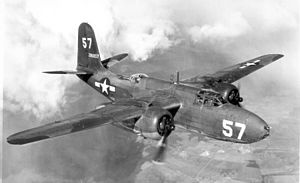| A-20 Havoc DB-7/Boston/P-70 | |
|---|---|
 A-20G of the United States Army Air Forces | |
| General information | |
| Type | |
| National origin | United States |
| Manufacturer | Douglas Aircraft Company |
| Primary users | United States Army Air Forces |
| Number built | 7,478 |
| History | |
| Manufactured | 1939–1944 |
| Introduction date | 10 January 1941 |
| First flight | 23 January 1939 |
| Retired | (USAF) 1949 |
| Developed into | Douglas DC-5 |
The Douglas A-20 Havoc (company designation DB-7) is an American light bomber, attack aircraft, night intruder, night fighter, and reconnaissance aircraft of World War II.
Designed to meet an Army Air Corps requirement for a bomber, it was ordered by France for their air force before the USAAC decided it would also meet their requirements. French DB-7s were the first to see combat; after the fall of France, the bomber served with the Royal Air Force under the service name Boston. From 1941, night fighter and intruder versions were given the service name Havoc. In 1942 USAAF A-20s saw combat in North Africa.
It served with several Allied air forces, principally the United States Army Air Forces (USAAF), the Soviet Air Forces (VVS), Soviet Naval Aviation (AVMF), and the Royal Air Force (RAF) of the United Kingdom. A total of 7,478 aircraft were built, of which more than a third served with Soviet units. It was also used by the air forces of Australia, South Africa, France, and the Netherlands during the war, and by Brazil afterwards.[1]
In most British Commonwealth air forces, the bomber variants were known as Boston, while the night fighter and intruder variants were named Havoc. The exception was the Royal Australian Air Force, which used the name Boston for all variants.[2] The USAAF used the P-70 designation to refer to the night fighter variants.
- ^ Parker 2013, pp. 11, 18–19.
- ^ Crick, Darren. "RAAF A28 Douglas A-20A/C/G Boston". Archived 2013-12-06 at the Wayback Machine ADF Aircraft Serial Numbers, 2009, Retrieved: 24 January 2013.